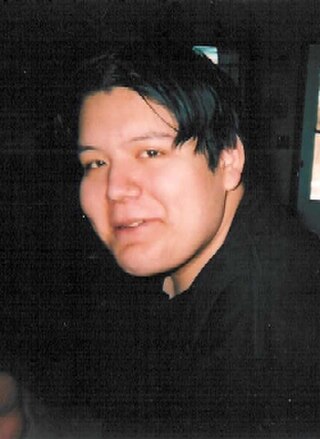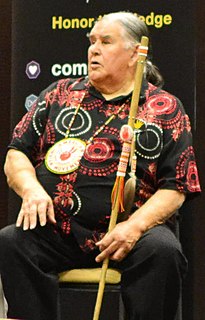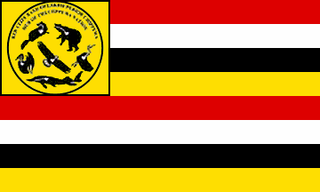
The Sioux or Oceti Sakowin are groups of Native American tribes and First Nations peoples in North America. The modern Sioux consist of two major divisions based on language divisions: the Dakota and Lakota; collectively they are known as the Očhéthi Šakówiŋ. The term "Sioux" is an exonym created from a French transcription of the Ojibwe term "Nadouessioux", and can refer to any ethnic group within the Great Sioux Nation or to any of the nation's many language dialects.

Red Lake is a census-designated place (CDP) within the Lower Red Lake unorganized territory located in Beltrami County, Minnesota, United States. As of the 2020 census, Red Lake had a total population of 1,786. The Red Lake Indian Reservation is based in Red Lake.
The Wisconsin Walleye War became the name for late 20th-century events in Wisconsin in protest of Ojibwe hunting and fishing rights. In a 1975 case, the tribes challenged state efforts to regulate their hunting and fishing off the reservations, based on their rights in the treaties of St. Peters (1837) and La Pointe (1842). On August 21, 1987, the U.S. District Court Judge Barbara Crabb ruled that six Ojibwe (Chippewa) tribal governments had the right under these treaties for hunting and fishing throughout their former territory.
Public Law 280, is a federal law of the United States establishing "a method whereby States may assume jurisdiction over reservation Indians," as stated in McClanahan v. Arizona State Tax Commission. 411 U.S. 164, 177 (1973).

The Red Lake Indian Reservation covers 1,260.3 sq mi in parts of nine counties in northwestern Minnesota, United States.

The Bad River LaPointe Band of the Lake Superior Tribe of Chippewa Indians or Bad River Tribe for short are a federally recognized tribe of Ojibwe people. The tribe had 6,945 members as of 2010. The Bad River Reservation is located on the south shore of Lake Superior and has a land area of about 193.11 square miles (500.15 km2) in northern Wisconsin, straddling Ashland and Iron counties. Odanah, the administrative and cultural center, is located five miles (8.0 km) east of the town of Ashland on U.S. Highway 2. The reservation population was 1,545 in 2020. Most of the reservation is managed as undeveloped forest and wetland, providing a habitat for wild rice and other natural resources.

Dennis Banks was a Native American activist, teacher, and author. He was a longtime leader of the American Indian Movement, which he co-founded in Minneapolis, Minnesota in 1968 to represent urban Indians.

Red Lake Secondary Complex, formerly Red Lake Senior High School, is a public state-funded high school in unincorporated Red Lake, in Beltrami County, northern Minnesota, United States. The high school is located on the Red Lake Indian Reservation on which members of the Red Lake Band of Chippewa (Ojibwe) Indians live, and has over 300 students. The school's mascots are the Ogichidaag and Ogichidaakwag. The school also hosts its own radio station, Ka-MOD. The school is a part of Red Lake School District.

Jeffrey James Weise was an American student at Red Lake Senior High School in Red Lake, Minnesota, who committed the Red Lake shootings on March 21, 2005.

Clyde Howard Bellecourt was a Native American civil rights organizer. His Ojibwe name is Nee-gon-we-way-we-dun, which means "Thunder Before the Storm". He founded the American Indian Movement (AIM) in Minneapolis, Minnesota, in 1968 with Dennis Banks, Eddie Benton-Banai, and George Mitchell. His elder brother, Vernon Bellecourt, was also active in the movement.

The White Earth Indian Reservation is the home to the White Earth Band, located in northwestern Minnesota. It is the largest Indian reservation in the state by land area. The reservation includes all of Mahnomen County, plus parts of Becker and Clearwater counties in the northwest part of the state along the Wild Rice and White Earth rivers. It is about 225 miles (362 km) from Minneapolis–Saint Paul and roughly 65 miles (105 km) from Fargo–Moorhead.

The Minnesota Chippewa Tribe (MCT) is the centralized governmental authority for six Chippewa bands in the U.S. state of Minnesota. The tribe was created on June 18, 1934; the organization and its governmental powers are divided between the tribe, and the individual bands, which directly operate their reservations. The bands that make up the tribe are:

The Leech Lake Reservation is an Indian reservation located in the north-central Minnesota counties of Cass, Itasca, Beltrami, and Hubbard. The reservation forms the land base for the federally recognized Leech Lake Band of Ojibwe, one of six bands comprising the Minnesota Chippewa Tribe, organized in 1934. The Leech Lake Reservation has the second highest population of any reservation in Minnesota with White Earth Nation being the largest Minnesota Ojibwe tribe, Leech Lake Nation has a resident population of 11,388 indicated by the 2020 census.

The Leech Lake Band of Ojibwe, also known as the Leech Lake Band of Chippewa Indians or the Leech Lake Band of Minnesota Chippewa Tribe is an Ojibwe band located in Minnesota and one of six making up the Minnesota Chippewa Tribe. The band had 9,426 enrolled tribal members as of March 2014. The band's land base is the Leech Lake Indian Reservation, which includes eleven communities aggregated into three districts, as defined in the tribal constitution,

The Mille Lacs Band of Ojibwe, also known as the Mille Lacs Band of Chippewa Indians, is a federally recognized American Indian tribe located in east-central Minnesota. The Band has 4,302 members as of 2012. Its homeland is the Mille Lacs Indian Reservation, consisting of District I, District II, District IIa, and District III.

The Lac Courte Oreilles Tribe is one of six federally recognized bands of Ojibwe people located in present-day Wisconsin. It had 7,275 enrolled members as of 2010. The band is based at the Lac Courte Oreilles Indian Reservation in northwestern Wisconsin, which surrounds Lac Courte Oreilles. The main reservation's land is in west-central Sawyer County, but two small plots of off-reservation trust land are located in Rusk, Burnett, and Washburn counties. The reservation was established in 1854 by the second Treaty of La Pointe.

Red Cliff Band of Lake Superior Chippewa is a band of Ojibwe Native Americans. The Red Cliff Band is located on the Red Cliff Indian Reservation, on Lake Superior in Bayfield County, Wisconsin. Red Cliff, Wisconsin, is the administrative center. Red Cliff is notable for being the band closest to the spiritual center of the Ojibwe nation, Madeline Island. As of November 2010, there were 5,312 enrolled members, with about half living on the reservation and the rest living in the city of Bayfield or the Belanger Settlement.

The Battle of Sugar Point, or the Battle of Leech Lake, was fought on October 5, 1898 between the 3rd U.S. Infantry and members of the Pillager Band of Chippewa Indians in a failed attempt to apprehend Pillager Ojibwe Bugonaygeshig, as the result of a dispute with Indian Service officials on the Leech Lake Reservation in Cass County, Minnesota.
The Westside Middle School shooting was a school shooting on March 24, 1998, at Westside Middle School in unincorporated Craighead County, Arkansas near the city of Jonesboro. Perpetrators Mitchell Johnson, 13, and Andrew Golden, 11, fatally shot four students and a teacher with multiple weapons, and both were arrested when they attempted to flee the scene. Ten others were wounded. Golden and Johnson were convicted of five murders and ten assaults, and were imprisoned until each turned 21 years of age. After the 1992 Lindhurst High School shooting that killed four people in Olivehurst, California, the massacre was the deadliest non-college school shooting in contemporary U.S. history until the April 1999 Columbine High School massacre.
Roger Jourdain was an Ojibwe civic leader who served as chairman of the Red Lake Band of Chippewa from 1959 to 1990. Jourdain is credited with protecting Red Lake's extensive tribal sovereignty and improving tribal infrastructure during his tenure in office.















